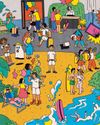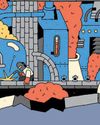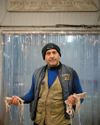
Things quickly get weird when you step inside the 19,000-square-foot Italian Pavilion at the Venice Biennale. The installation by artist Gian Maria Tosatti has no obvious wall text, signs, or directions.
There’s nothing to indicate how to walk through the chilly, fluorescent-lit rooms made to look like abandoned factories and sweatshops, with rows of desks and sewing machines. At the end you can walk—very tentatively—onto what appears to be a concrete pier surrounded by water in an almost pitch-black room.
It’s a nod to industrial decline and climate change that the artist intended to discomfit and unnerve. “When the curator asked me to do the Italian Pavilion, he asked me to make work around a statement about our future,” Tosatti says. “We had to create some sort of mirror that could show everyone what we are today—the ashes of a broken dream, a dream we had about a future, or a present, that isn’t sustainable.” He points to the pandemic, environmental degradation, and the war in Ukraine. “Now it’s all collapsed,” he says, “so what are we going to do about it?”
Every two years massive crowds form at the must-see installations of the Venice Biennale, widely considered the most important art show in the world. After a one-year delay because of Covid-19, excitement for the 59th edition, which opened in April, was even higher.
Diese Geschichte stammt aus der May 16, 2022-Ausgabe von Bloomberg Businessweek.
Starten Sie Ihre 7-tägige kostenlose Testversion von Magzter GOLD, um auf Tausende kuratierte Premium-Storys sowie über 8.000 Zeitschriften und Zeitungen zuzugreifen.
Bereits Abonnent ? Anmelden
Diese Geschichte stammt aus der May 16, 2022-Ausgabe von Bloomberg Businessweek.
Starten Sie Ihre 7-tägige kostenlose Testversion von Magzter GOLD, um auf Tausende kuratierte Premium-Storys sowie über 8.000 Zeitschriften und Zeitungen zuzugreifen.
Bereits Abonnent? Anmelden

Instagram's Founders Say It's Time for a New Social App
The rise of AI and the fall of Twitter could create opportunities for upstarts

Running in Circles
A subscription running shoe program aims to fight footwear waste

What I Learned Working at a Hawaiien Mega-Resort
Nine wild secrets from the staff at Turtle Bay, who have to manage everyone from haughty honeymooners to go-go-dancing golfers.

How Noma Will Blossom In Kyoto
The best restaurant in the world just began its second pop-up in Japan. Here's what's cooking

The Last-Mover Problem
A startup called Sennder is trying to bring an extremely tech-resistant industry into the age of apps

Tick Tock, TikTok
The US thinks the Chinese-owned social media app is a major national security risk. TikTok is running out of ways to avoid a ban

Cleaner Clothing Dye, Made From Bacteria
A UK company produces colors with less water than conventional methods and no toxic chemicals

Pumping Heat in Hamburg
The German port city plans to store hot water underground and bring it up to heat homes in the winter

Sustainability: Calamari's Climate Edge
Squid's ability to flourish in warmer waters makes it fitting for a diet for the changing environment

New Money, New Problems
In Naples, an influx of wealthy is displacing out-of-towners lower-income workers